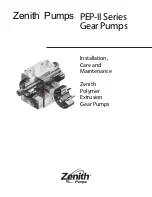
8
be adequate, or may need recalibration. (Detection equipment shall be calibrated in a refrigerant-
free area.) Ensure that the detector itself is not a potential source of ignition and is suitable for the
refrigerant used.
Leak detection equipment shall be set at a percentage of the “LFL” of the refrigerant and shall be
calibrated to the refrigerant employed and the appropriate percentage of gas (25 % maximum) is
confirmed.
Leak detection fluids are suitable for use with most refrigerants but the use of detergents containing
chlorine shall be avoided as the chlorine may react with the refrigerant and corrode the copper
pipework.
- If a leak is suspected, all naked flames shall be removed or extinguished.
- If a leakage of refrigerant is found which requires brazing, all of the refrigerant shall be
recovered from the system, or isolated (by means of shut off valves) in a part of the system
remote from the leak. Oxygen free nitrogen (OFN) shall then be purged through the system
both before and during the brazing process.
Removal and evacuation
• When breaking into the refrigerant circuit to make repairs or for any other purpose, conventional
procedures shall be used.
• However, it is important that best practice is followed since flammability is a consideration.
The following procedure shall be adhered to:
- Remove refrigerant.
- Purge the circuit with inert gas.
- Evacuate.
- Purge again with inert gas.
- Open the circuit by cutting or brazing.
• The refrigerant charge shall be recovered into the correct recovery cylinders.
• The system shall be flushed with OFN to render the unit safe. This process may need to be
repeated several times. Compressed air or oxygen shall not be used for this task.
Flushing shall be achieved by breaking the vacuum in the system with OFN and continuing to fill
until the working pressure is achieved, then venting to atmosphere, and finally pulling down to a
vacuum. This process shall be repeated until no refrigerant is within the system.
When the final OFN charge is used, the system shall be vented down to atmospheric pressure to
enable work to take place. This operation is absolutely vital if brazing operations on the pipework
are to take place.
Ensure that the outlet for the vacuum pump is not close to any ignition sources and there is
ventilation available.
Charging procedures
• In addition to conventional charging procedures, the following requirements shall be followed:
- Ensure that contamination of different refrigerants does not occur when using
charging equipment.
- Hoses or lines shall be as short as possible to minimize the amount of refrigerant
contained in them.
- Cylinders shall be kept upright.
- Ensure that the refrigeration system is earthed prior to charging the system with
refrigerant.
- Label the system when charging is complete (if not already done).
- Extreme care shall be taken not to overfill the refrigeration system.
- Prior to recharging the system it shall be pressure tested with OFN.
- The system shall be leak tested on completion of charging but prior to commissioning.
- A follow up leak test shall be carried out prior to leaving the site.
Leak detection methods
Before carrying out this procedure, it is essential that the technician is completely familiar with the
Содержание HCNI 533
Страница 1: ...MARK HEAT PUMP SPLIT UNIT 0662680 Technical manual EN...
Страница 2: ...2...
Страница 16: ...16 3 4 Outdoor Units Printed Circuit Board Diagram HCNMX 353 HCNI 533...
Страница 81: ...81 EN...
Страница 82: ...82...
Страница 83: ...83 EN...









































